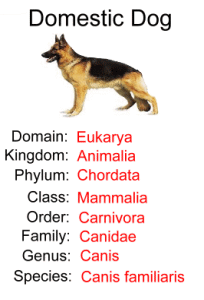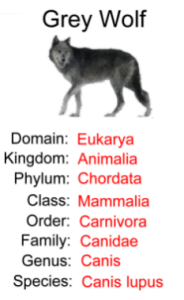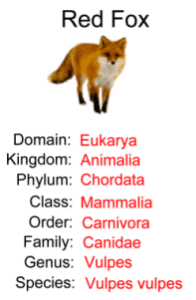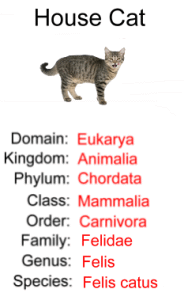 Taxonomy is a branch of science that deals with the description, identification, naming, and classification of organisms. It is essential to classify living organisms into different groups and subgroups. In biology, taxonomy is defined as the classification of biological organisms. Modern scientists use both physical and genetic evidence to classify organisms The classification system, or taxonomy, commonly used today has eight levels. From the most general to the most specific, these are domain, kingdom, phylum, class, order, family, genus, and species. (For plants, the term 'division' is often used instead of phylum.) Each level is contained, or nested, within the level above it. For example, a genus contains one or more species; a family contains one or more genus; an order contains one or more families; and so on. The domain is the highest level of organization and is the largest group. DOMAIN The domain is the highest rank in biological classification. There are three: Archaea, Bacteria, and Eukarya. The Archaea and Bacteria each contain prokaryotes (single-celled organisms with no true nucleus) but differ in structural, genetic, and biochemical characteristics. The domain Eukarya is everything else; it contains eukaryotes - organisms whose cells contain a nucleus and membrane-bound organelles. KINGDOM There are six kingdoms: The kingdoms Archaea and Bacteria each constitute a separate domain. The Protista, Fungi, Plants and Animals all belong to the domain Eukarya. PHYLUM Organisms are classified in a phylum based largely on general body plan. There are 36 animal phyla, but only nine (Mollusca, Porifera, Cnidaria, Platyhelminthes, Nematoda, Annelida, Arthropoda, Echinodermata, and Chordata) contain the vast majority of existing species. For example: CLASS Members of a class share more characteristics with each other than they do with other organisms in the same phylum. For example, amphibians and reptiles both belong to the phylum Chordata, but each belongs to a different class. While members of class Amphibia (frogs, toads, and salamanders) have moist, smooth skin and reproduce by laying large quantities of jellylike eggs in water, members of the class Reptilia (snakes, lizards, turtles, and tortoises) have dry scaly skin and reproduce by laying small clutches of leathery eggs on land. ORDER Groups in an order have more in common with each other than they do with other members of the same class. For example, reindeer and whales both belong to the class Mammalia and share the basic traits of mammals. However, each belongs to a different order. Reindeer are part of the order Artiodactyla, which includes cloven-hoofed mammals like cows, pigs, antelope, and giraffes. Whales belong the order Cetacea, a marine mammal order that includes porpoises and dolphins. FAMILY Members of the same taxonomic family are more closely related to each other than they are to other members of the same order. For example, foxes, coyotes, lions, cats, otters, and weasels all belong to the order Carnivora. However, foxes and coyotes belong to the family Canidae. Lions and cats belong to the family Felidae; otters and weasels are part of the family Mustelidae. GENUS The groups of organisms in a genus share many structural similarities and are very closely related. Members of a genus are more closely related to each other than they are to other genera in the same family. The cat family, Felidae, includes lions, tigers, ocelots, domestic cats, bobcats, and lynx. However, lions and tigers belong to the genus Panthera, ocelots and domestic cats are part of the genus Felis, and lynx and bobcats are in the genus Lynx. SPECIES Members of the same species share the same evolutionary history and are more closely related to each other than they are to any other organisms, including other members of the same genus. Organisms are grouped into a species based on physical and genetic similarities. All members of a species have the same number of chromosomes. Members of a species can successfully mate and produce viable offspring (those that can in turn breed and produce more offspring). Individuals of the same species can successfully interbreed with one another but almost never with members of other species. (Different species within a genus occasionally produce hybrid offspring, but these are almost always sterile). Each species has its own scientific name, composed of the genus name and species name. For example, the lionís scientific name is Panthera leo, and the tiger's is Panthera tigris. Some species include groups with such distinctive traits that they are classified as a subspecies; in these cases, a subspecies name is added to the end of the species name. For example, Panthera tigris includes the Siberian tiger (Panthera tigris altaica) and the Bengal tiger (Panthera tigris tigris) In general, the more levels that species share, the more closely they are related. For example, Gray wolves (Canis lupus), and domestic dogs (Canis familiaris), both belong to the same top seven levels (domain, kingdom, phylum, class, order, family, and genus). This indicates that these species share many physical and genetic traits and are closely related. Below are some more examples. Notice that:



 Below are examples that diverge even more widely, because of different divisions higher on the classification chart. Notice that:
 Finally, here is the taxonomy for human beings. Notice that:
Finally, here is the taxonomy for human beings. Notice that:
|